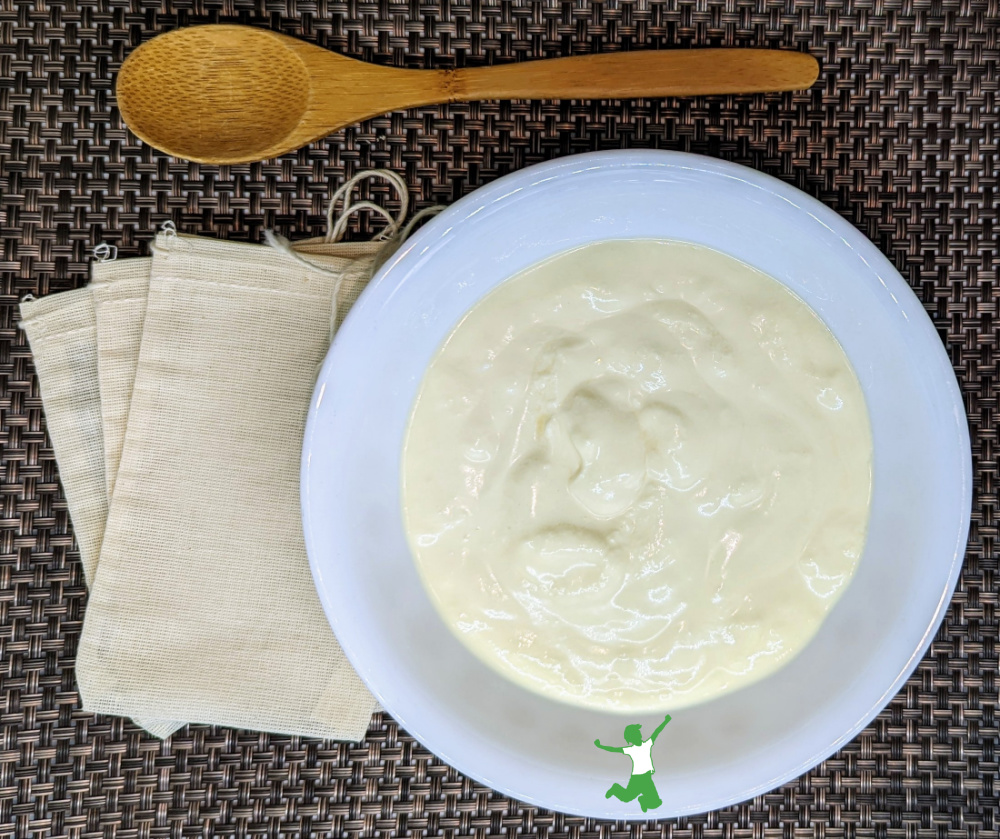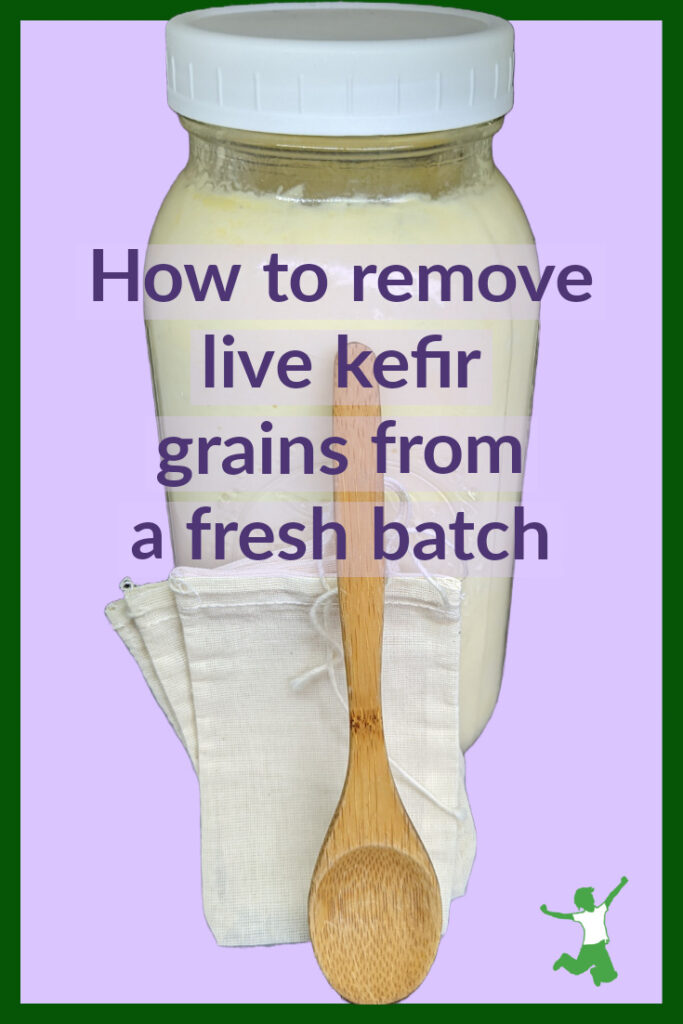How to easily remove live grains from a fresh batch of homemade kefir without making a mess or losing some of the culture down the sink.

A friend of mine recently started making dairy kefir at home for the very first time.
He fermented his first few batches using organic pasteurized milk.
He had been under the (false) impression that the probiotics in raw milk “would compete” with the live kefir grains and impede fermentation.
Sadly, this myth continues to circulate in the alternative health community.
After we talked about why this was a myth and the benefits of raw grassfed milk, he switched to making it with fresh-from-the-cow instead.
And wow! He has really been enjoying the huge upgrade in health benefits as well as the improved texture and taste!
The nutritional content of raw kefir is far greater than pasteurized too. At least half the Vitamin C and all the beneficial enzymes (like lactase) are destroyed during processing, among other problems.
Live Starter is ALWAYS Best
The main benefit of using live kefir grains over powdered starter is that the kefir contains roughly three dozen probiotics including beneficial yeast strains.
This compares to the handful of strains from inferior powdered starter or improperly fermented commercial kefir.
The live grains last for decades too. It is the most frugal approach as well as the healthiest.
You can even pass them on to your kids (I’m serious).
Removing Kefir Grains is a Challenge
The only downside of using a living culture to ferment kefir is fishing out the gummy-like grains from each batch.
The process is tedious and messy.
Worse, it can sometimes result in some precious grains getting washed down the sink accidentally as you rinse the wooden strainer (like this one).
It is best to never use metal as it weakens the living kefir culture. Plastic is acceptable, but who wants to use a nonsustainable material if avoidable?
You can also use your fingers to fish them out a few at a time. This is super messy though.
Is there an easier way that is safe for the grains and won’t weaken them?
Yes, there is!
Easiest Way to Remove Grains from Kefir (without harming them)
Over the years, I’ve refined my method for removing kefir grains from each batch without harming or losing them!
By far, the simplest way to accomplish this is by using small muslin drawstring bags made with 100% cotton. These are the unbleached bags I use.
Do NOT use the plastic or metal cage strainers some sites misguidedly recommend.
Be aware that cotton muslin bags come in a variety of sizes.
I suggest sticking with the small ones. My hunch is that larger bags may inhibit fermentation in some way.
All you have to do is carefully put your kefir grains in one of the bags.
I suggest washing the bag with filtered water and mild unscented Castile soap first. Rinse well in filtered water before using (chlorine in tap water harms the grains). No need to dry the bag first.
After placing the grains inside one of the bags, gently lower the bag into the mason jar containing the milk you intend to ferment.
Close the lid of the jar with the edge of the drawstrings over the side of the rim. This keeps the bag from sinking to the bottom of the jar.
After 24-hour fermentation is complete (it might take slightly longer…up to 36 hours), carefully unscrew the lid and catch hold of the drawstrings with your fingers or a spoon.
Carefully pull the bag out of the fresh batch of kefir and place it in a clean bowl.
No need to rinse the bag or remove/rinse the grains between batches!
Simply lower the bag of kefir grains into a fresh mason jar of milk to start your next batch!
Easy peasy 🙂
Each muslin bag will last several months. To give you some idea, we make a fresh batch of kefir almost every day, and we use about a half dozen cotton bags each year.
While the bags are not expensive, if you have one or two friends who also make kefir, it is most frugal to split a larger order of bags amongst the group.









Usually the first sign of weakening is the disappearance of kefiran. The slimy mucous strings amongst the grains go away and the kefir stops being gooey. Rinsing with water will do this. Next sign will be decreased effervescence, even though it may increase initially as the scoby balance changes. Next, the fermentation time will increase and the multiplication of the grains will slow down or stop. Finally, color and smell will change for the worse.
I never have any slimy mucous strings between my kefir grains. Effervescence is also not a reliable indicator as it ebbs and flows depending on the season, warmth in the house and other factors. None of what you are saying indicates with precision that the grains are just as strong when you use a metal strainer. They might appear to be as strong, but it might be that some (of the roughly 3 dozen) strains have disappeared entirely with fermentation time remaining virtually unchanged. Remember that powdered kefir starter only has a few strains while live grains have dozens … and they ferment the milk in roughly the same amount of time.
The weakening effect of metal is never well explained. I strain with a stainless steel colander with no noticeable effect on vigor.
Have you actually tested your kefir for probiotic strength to confirm this or does it just “seem” to have no noticeable effect?
Kefir in any amount gives me palpitation, and same with fermented vegetables. Please lmk the science behind this reaction or lead me to some article or book to read. I miss it so much. Thx
Are these bags made from organic cotton? Regular grown cotton is heavily sprayed before harvesting.
Thanks!
They are made of unbleached cotton … I haven’t found organic ones, but if you wash well in mild dishsoap and water and then rinse in filtered water before using, I consider them very safe to use.
Hi Sarah!
I literally JUST strained my kefir grains before I saw this. 🙂
I recently started making raw dairy kefir again, I’d forgotten how simple it is.
I make it 1-2x/week & use in smoothies. Does everyone in your family drink it straight? Or how else do you use it?
Kelly
I have a cup straight every morning and so does my husband 🙂 A GREAT start to the day and gets digestion going in the right direction.
I have been using the same tuna cans strainer on my kefir since 2001. The teeny tiny grains are sometimes lost but I have had hundreds of giant grains that I have shared with people all over the world in these last 20+ years. Using this bag seems very unsanitary to me. Yuck. Thank you for the suggestion, but I will stick to my tuna can strainer which has showed me it is tried and true and fine.
Metal and rinsing the grains between batches have a weakening effect on the live grains. VERY surprised you do this. And no, the bags aren’t unsanitary at all if you try it 🙂
I’m trying to get into making kefir but I can’t find grains… do you think it’s safe to buy them off someone in Etsy!
I think so … just check that their reviews are good. I just bought some cassava cuttings off Etsy and they are flourishing since planting them!
My raw dairy farm switched to A2 cows. The kefir I made from it (using powder) tasted too yeasty. Tried it a few times. So I had to stop. Raw milk is too expensive to not enjoy the kefir. I sure miss it though. Have used grains in past, but then have trouble maintaining them when we travel. Any comment Sarah?
I recommend to never use powdered started for kefir. It has no therapeutic value. https://www.thehealthyhomeeconomist.com/best-kefir-starter/
I have been scooping grains off the top with a wooden spoon putting them in a bowl while I put the rest of kefir in a jar for eating and store in fridge! Then I put the grains in a new jar with raw milk for new batch and cover lightly and set on counter! No waste I just drink everything!
Yes, this works as well. You do end up eating some of the grains though. Used this method for years until I switched to the muslin bag.
What a fantastic idea! I’m going to get some bags right away. Also, I’ll start making my kefir with raw milk, now that you’ve clarified that raw milk probiotics don’t complete with the kefir grains. Many thanks for two very helpful tips.